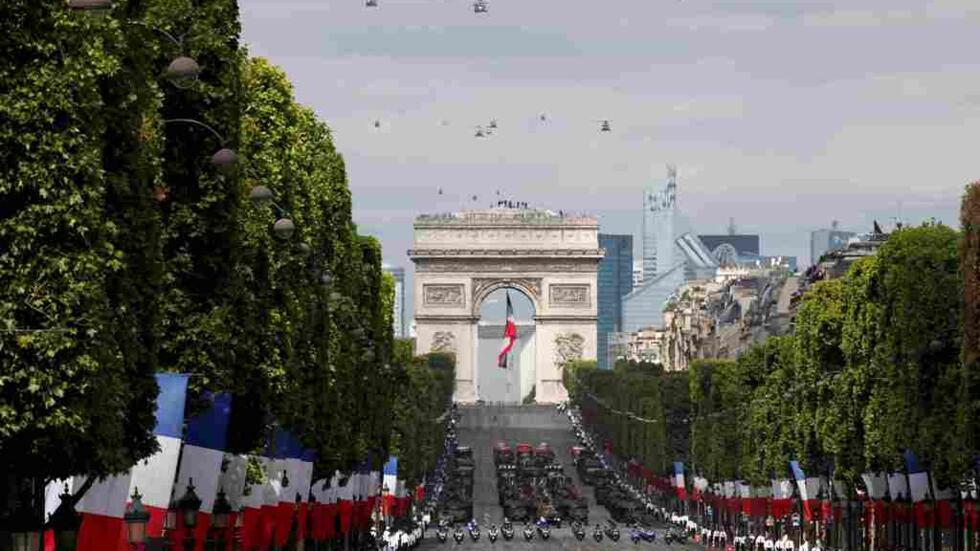Bastille Day parade unrolls under shadow of anti-terror fight
France’s annual Bastille Day military parade took place on Paris’s Avenue des Champs-Elysées on Tuesday morning. Six months after the Paris Charlie Hebdo attacks, the parade and its onlookers were surrounded by signs of France’s fight against terrorism at home and abroad.
Issued on: Modified:

Military helicopters flew over the crowd of French citizens and curious visitors gathered on the famous Paris avenue, watching a procession of approximately 3,500 soldiers and security personnel, as well as 55 planes, 208 armoured vehicles and 237 horses.
“It’s very good to know about,” said Taka Hasegawa, who along with his companion is visiting from Tokyo and just learned about the parade Tuesday morning. “We’ve watched the planes, the armies and now we are watching the tanks. It’s very impressive.”
“It is the French celebration, so we thought it was important to meet some French people and have fun today,” said Roy Spenkalink, a Dutch man visiting Paris for the first time with his wife.
“I believe it’s important to know more about the army, and it’s a great opportunity to see them,” said French man Vincent Perraud, who came to the parade for the first time after watching previous ones on television. “It’s part of the duty of a citizen, to know about it.”
This year’s parade honoured veterans who fought to liberate France in the closing months of World War II, as well as the end of the fighting 70 years ago.
More current events also marked the ceremonies, including the official participation of the parade’s guest of honour, Mexican President Enrique Pena Nieto, as well as approximately 150 Mexican soldiers who took part in the march.
“I’m French, I live in France, and it’s the first time I’ve come here, because Mexico was invited,” said Christine Riet, whose mother is Mexican and who had come to the parade sporting a Mexico T-shirt to play her own part in rebuilding diplomatic ties between the two countries.
“A few years ago, there was a little bit of a misunderstanding, so I am now hoping for a new era,” she says, referring to a spat over French woman Florence Cassez, who was repatriated to France in 2013 after spending eight years in a Mexican prison on a conviction for kidnapping and involvement in organised crime.
But it was France’s war on terror that cast the longest shadow over the march.
For the first time, the parade featured the participation of three elite police forces – Raid, BRI, and GIGN – that carried out assaults against the suspects in January’s attacks on Charlie Hebdo and kosher market Hyper Cacher.
The effects of those events were more sombrely apparent on the sidelines, among the onlookers, who were being closely watched by security personnel: some 11,200 military and police were deployed around the capital to ensure security - more than three times the number taking part in the parade itself.
And the military’s own participation was slightly downsized compared with previous years, with 250 less personnel and about 80 fewer vehicles.
The parade was 15 minutes shorter than usual and a meeting between soldiers and civilians traditionally held in the afternoon was cancelled.
While not out of security concerns directly, these shortages were due to the army’s missions at home and abroad in response to the attacks, which had “overtaxed” and “exhausted” the soldiers, announced General Hervé Charpentier, military governer of Paris, ahead of the parade.
Charpentier expressed regret over the reduced participation but said it was “necessary so our soldiers could recuperate and be prepared in the long term”.
In addition to the parade itself, the armed forces were also visible in a more subtle way, through thousands of cheap plastic flags handed out to onlookers.
Featuring the red, white and blue of the French tricoloured flag on one side, the reverse featured the logo of the armed forces above a web address and a simple message: that the French army is looking for recruits.
“We need to wave it, I guess,” says Roy Spenkalink. “Vive la France!”
Daily newsletterReceive essential international news every morning
Subscribe